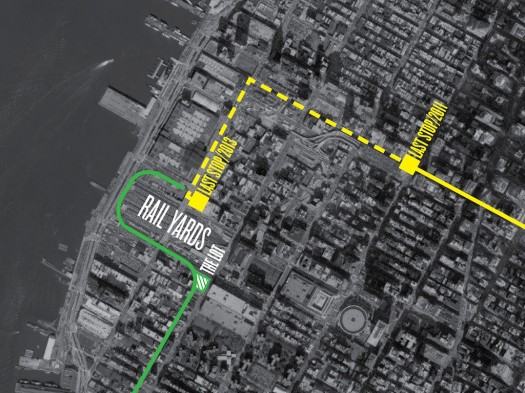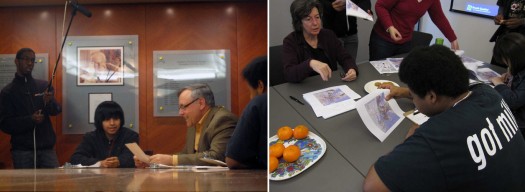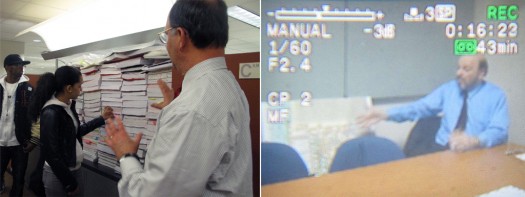
We are celebrating 15 years — and counting — of stories that are deeply researched and deeply felt, that build a historical record of what the city has been.
We are celebrating 15 years — and counting — of stories that are deeply researched and deeply felt, that build a historical record of what the city has been.
In late 2013, the MTA will complete a 2-mile extension of the 7 line, from its current terminus at Times Square to 34th Street and 11th Avenue. Improving transit access to the far west side of Manhattan is part of a far-reaching City plan to activate the Hudson Yards area, an “under-utilized” neighborhood in Manhattan roughly bounded by West 43rdStreet, West 28th Street, Eighth Avenue and the Hudson River, with commercial, residential, cultural and public space development. The area is currently served by buses — including the M42, which received the shameful Pokey Award last year for being the slowest bus in New York — but subway access is as far away at Times Square or Penn Station. But in a time of limited financial resources and other pending transit projects that would serve already-bustling communities with comparable transportation expansion needs, how was the decision made to extend the 7 line?
In spring 2011, Alexandra Woolsey Puffer and Jeff Maki, as teaching artists for the Center for Urban Pedagogy (CUP), posed that very question to a group of ninth, tenth and eleventh graders. CUP is a nonprofit organization that uses art and design to improve public participation in shaping the places where we live. Fast-Tracked is the latest in CUP’s “Urban Investigations,” a series of project-based after-school programs that ask high school students to explore fundamental questions about how the city works and translate their findings into multimedia teaching tools for audiences in the arts and social justice professions. For Fast-Tracked, they worked with students from the New Design High School on the Lower East Side of Manhattan who are participating in College Now, a free City University of New York program designed to prepare New York City’s public high school students for success in college. Over the course of 15 weeks, the students, led by the team from CUP, investigated how transportation planning works by talking to stakeholders, researching policy and financing, and pounding the pavement. Here, Woolsey Puffer and Maki share their students’ story of the 7 line extension and what they learned about who determines the shape and flow of our public transportation. — V.S.
WHAT DIFFERENCE DOES A SUBWAY MAKE?
What’s the connection between subways and (re)development? Which comes first, the subway or the people? And why doesn’t the bus get any love? These are the questions that formed the basis of our CUP Urban Investigation in collaboration with ninth, tenth and eleventh grade students who are part of the College Now program at the New Design High School.
We began our investigation by exploring the fundamentals of mass transit. We posed the question to our students: is a subway system built for aliens the same subway system a pirate would want to use? Different riders want to visit different places, and everyone has his or her own idea of the path the subway should follow and the stops it should make. With 8 million people living in New York, there is no easy solution. Because transit needs to serve so many different types of riders, the name of the game is tradeoffs.
Access to transit, for businesses and for residents, is access to opportunity. Subways bring people to places they need to go — for work, for fun, to eat, to get home — and living close to transit increases options for all of those activities. But the longer the journey takes, the less practical it becomes, especially early in the morning or late at night, when transit service is less frequent.
By analyzing where subway stations are located in their own neighborhoods, how they are used and how they impact their surroundings, the students recognized the importance of efficient, reliable public transportation in everyday life. From that basic understanding, we began to look closely at one new subway development currently underway in New York: the extension of the 7 train westward, from its current final stop at Times Square to 34th Street and 11th Avenue.
By December 2013, this $2.1 billion 7 line extension will take riders to Hudson Yards, a 26-acre “under-utilized” area on the far west side of Manhattan. If you visit the area today, you’ll find check-cashing stops, parking lots, car repair garages, the entrance to the Lincoln Tunnel and the Javits Convention Center. Few people live there and at first there does not appear to be strong demand for a new subway station. “This is the middle of nowhere,” summarized Shadiq Williams, a student at New Design High School. But a proposed redevelopment of the area will transform the MTA’s West Side Rail Yard into a multi-use residential and commercial complex — and improved access to transit is a key part of the redevelopment plan.

The Hudson Yards redevelopment area. The current/future route of the 7 line (solid/dashed yellow) and the newly redeveloped High Line (green).
WHO DECIDES WHERE THE SUBWAY GOES?
So, did (re)development follow from the plan to extend the subway, or did the subway follow the development? We turned to four people with markedly different viewpoints on transportation planning and real estate development to find out how the decision was made to extend the 7 train to Hudson Yards — and ended up with many different answers to the questions of who decides where the subway goes and how those choices are made.
Steven Spinola, president of the Real Estate Board of New York (REBNY) and a former deputy mayor of economic development, told us about the tradeoffs politicians are required to make when allocating limited financial resources. “Do we spend it on police? On education? On infrastructure? You spend it on all of them,” he explained, “but in what proportion? It’s a judgment call, but that’s what government people are elected to do.” When deciding how much to spend on improving mass transit, politicians must consider the broader implications of the proposed project. For Spinola, the redevelopment of areas like Hudson Yards and improved subway access to the neighborhood help create what he referred to as “another infrastructure” — namely, office space — and can generate construction jobs during a tough economic climate.

Students interview REBNY President Steven Spinola (L) and Pratt Center for Community Development Director of Policy Joan Byron (R)
We got a very different perspective on the issue when we talked to Joan Byron, Director of Policy, and Elena Conte, Organizer for Public Policy Campaigns, at the Pratt Center for Community Development in Brooklyn, where transportation is a social justice issue. “The short answer is that the MTA decides. But the bigger question is, who wields the most influence over the MTA?” Byron said. “Who has power over legislators? Those folks have the most input.” Byron and Conte noted that lower-income residents of the city typically don’t have a strong voice in transportation planning issues, particularly in comparison to real estate developers, and are often left with slower, less-reliable transit options.
Bus Rapid Transit | Illustration by the Fast-Tracked student team
An imbalance in efficient transit access is one of the reasons Byron and Conte are strong supporters of Bus Rapid Transit (BRT). BRT is bus service that acts like a subway, with dedicated travel lanes and platforms for efficient entry and exit. Just like the subway, you pay your fare before getting on the bus. BRT is more practical and cost-effective to build and operate than the subway — $1 million per mile to build here in New York City, as opposed to an approximate $1 billion per mile cost to build a subway — so why isn’t there more BRT in New York?
To investigate why the MTA prioritizes specific transit modes for certain sites we turned to Mark Schiffman, vice president of MTA Capital Construction, the department responsible for “mega projects,” such as the 7 line extension, the Fulton Street Transit Center and the Second Avenue subway. Mark showed us renderings of the proposed development for Hudson Yards and maps of where the subway is being extended underground, and addressed some of our questions about the new station and the process of deciding where the subway goes.

Students meet with MTA Capital Construction VP Mark Schiffman (L) and DCP consultant Sandy Hornick (R)
“It used to be that one individual, such as Robert Moses, would determine in large measure where a public works project would go,” Schiffman told us. If that one person preferred highways and bridges to public transit, for instance, then priority was given to building roads. Today, it’s harder to figure out exactly who decides; it is a process with many players and multiple steps. One key piece of the process is the Environmental Impact Statement (EIS), which, as its name suggests, identifies the potential effects a project will have on the environment of the city — traffic flow, patterns of light and shadow, ecology, infrastructure and more. An EIS is required by the federal government for any project that receives federal funds. But, Schiffman pointed out, no federal funds are being used for the 7 line extension. The MTA saw an opportunity to fast-track the development by financing the project with bonds. Yet the MTA still chose to undergo the EIS process, a decision made, Schiffman told us, “to prevent one individual from playing king.”
Sandy Hornick, a consultant to the New York City Department of City Planning, elaborated on what Mark Schiffman introduced to us: the EIS process, ULURP (the Uniform Land Use Review Procedure, a public review process for zoning changes), and the “creative financing” of the project that, as Schiffman described, would “fast-track” its development. Hornick explained that the 7 line extension is being funded through municipal bonds rather than state or federal monies, which come with restrictions and long-term financial unpredictability. Distilling the complex financial processes down to their essence, Hornick summarized: “All of this development will generate a lot of revenue. And we can borrow against this future revenue and use those bonds to pay for the subway.” Other transit projects that are funded by the federal or state government receive money over a certain period of time, after which they have to hope that funding will continue so that they can proceed with construction. With this project, as Schiffman said, “the money is in the bank, so we have certainty that we’ll be able to build.”
BACK IN THE CLASSROOM AND OUT ON THE STREET
Back in the classroom, we had our field notes, the recordings and transcriptions of our interviews, and an understanding of a new vocabulary we had encountered when talking to our interviewees. Now, we had to make sense of it all. What did our stakeholders tell us about the decision-making process? What are the issues at play? The alternatives? What can we do as citizens to affect the process?
To put things in perspective, the students created a timeline. From the transcripts, we cut out process-related quotes from each of our four interviewees and sorted them chronologically, from the very beginning of the project to the present, to help us understand what actually happened across organizations and from different perspectives.
Newly informed, we decided to revisit Hudson Yards and visualize the complete process of the 7 line extension in real space. We identified “six steps” to the project: Planning, Analysis/Scoping, Financing, Rezoning (ULURP), Agreement/Memo of Understanding,and Construction. With student-drawn placards that illustrated these six phases in hand, we organized a “process-ion” along the path of the subway extension — starting at 8th Avenue and 41st Street, continuing across 41st Street to 11th Avenue, and then turning south to 11th Avenue and 34th Street. We marked each of the six steps above ground, while tracing the path of the new subway tunnel beneath our feet.
The final installment of our Urban Investigation was to share the story of the 7 line extension with a larger audience. We created a newspaper to inform others about what we had learned. We included quotes from our stakeholders, our own thoughts on the project, and the drawings we created to represent the six steps of the process. The newspaper — “This is a Story of the 7 Line Extension and the Hudson Yards Redevelopment Project” — will be distributed along the 7 line and beyond. (Click here to download a PDF copy.)
Our exploration of transportation planning in New York City was full of surprises. What surprised our students the most was the fact that there is no public vote. The messiness of real-world politics, as we learned from each interview, was a lesson in the constraints and tradeoffs that need to be made in government and public policy.
More, though, than the process of figuring out who decides, we learned that behind government process there is an entire team of dedicated public servants (and lobbyists and advocates) who are willing and even excited to talk about their work. At a stage in life where the students are trying out their adult selves, it is important to find ways to practice the role of “engaged citizen.” Elected officials really do owe us all their time and accountability — especially in cases where public input is often limited to community boards composed of appointed officials.
One student remarked that transportation issues became more legible to her when she traveled from Queens to Red Hook for a summer internship at Congresswoman Nydia Velázquez’s office. She said that the trip took longer than she had hoped it would each day, and there weren’t adequate transportation options. Her participation in this investigation into transit planning had heightened her awareness of the gaps in efficiency in her own commute and helped her imagine how to create change. We hope that by helping our students understand public process a little better, they will be more likely to take an active role in their own communities and help ensure that a diversity of voices and interests are represented as our city’s policies and plans are made.
Fast-Tracked is a collaboration of CUP Teaching Artists Alexandra Woolsey Puffer and Jeff Maki with CUP staff and students from College Now at New Design High School: Sarai Arroyo, Kharee Boyd, Lawrence Daise, Juan Garcia, Steven Meijas, Isaiah Ortiz, Dahyana Santos, Aldo Sorcia, Ronex Tse and Shadiq Williams. We’d like to thank our student crew who spent 15 weeks after school to find out who decides where the subway goes.
The views expressed here are those of the authors only and do not reflect the position of The Architectural League of New York.
Comments